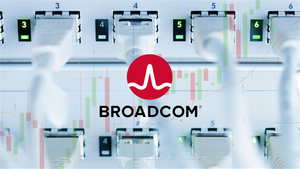
Semi trailers and liquid transportation container manufacturer Wabash (NYSE: WNC) missed Wall Street’s revenue expectations in Q1 CY2025, with sales falling 26.1% year on year to $380.9 million. The company’s full-year revenue guidance of $1.8 billion at the midpoint came in 3.9% below analysts’ estimates. Its non-GAAP loss of $0.58 per share was significantly below analysts’ consensus estimates.
Is now the time to buy Wabash? Find out by accessing our full research report, it’s free.
Wabash (WNC) Q1 CY2025 Highlights:
- Revenue: $380.9 million vs analyst estimates of $409.9 million (26.1% year-on-year decline, 7.1% miss)
- Adjusted EPS: -$0.58 vs analyst estimates of -$0.28 (significant miss)
- Adjusted EBITDA: -$9.20 million vs analyst estimates of $5.86 million (-2.4% margin, significant miss)
- The company dropped its revenue guidance for the full year to $1.8 billion at the midpoint from $2 billion, a 10% decrease
- Adjusted EPS guidance for the full year is -$0.60 at the midpoint, missing analyst estimates by 201%
- Operating Margin: 82.6%, up from 5.7% in the same quarter last year
- Free Cash Flow was -$8.97 million compared to -$36.6 million in the same quarter last year
- Backlog: $1.2 billion at quarter end, down 33.3% year on year
- Market Capitalization: $421.2 million
"During the first quarter, our GAAP EPS was $5.36, primarily as a result of recognizing a $342 million gain in connection with the reduction of a legal verdict," said Brent Yeagy, president and chief executive officer.
Company Overview
With its first trailer reportedly built on two sawhorses, Wabash (NYSE: WNC) offers semi trailers, liquid transportation containers, truck bodies, and equipment for moving goods.
Sales Growth
A company’s long-term sales performance is one signal of its overall quality. Even a bad business can shine for one or two quarters, but a top-tier one grows for years. Wabash’s demand was weak over the last five years as its sales fell at a 3.6% annual rate. This was below our standards and suggests it’s a low quality business.
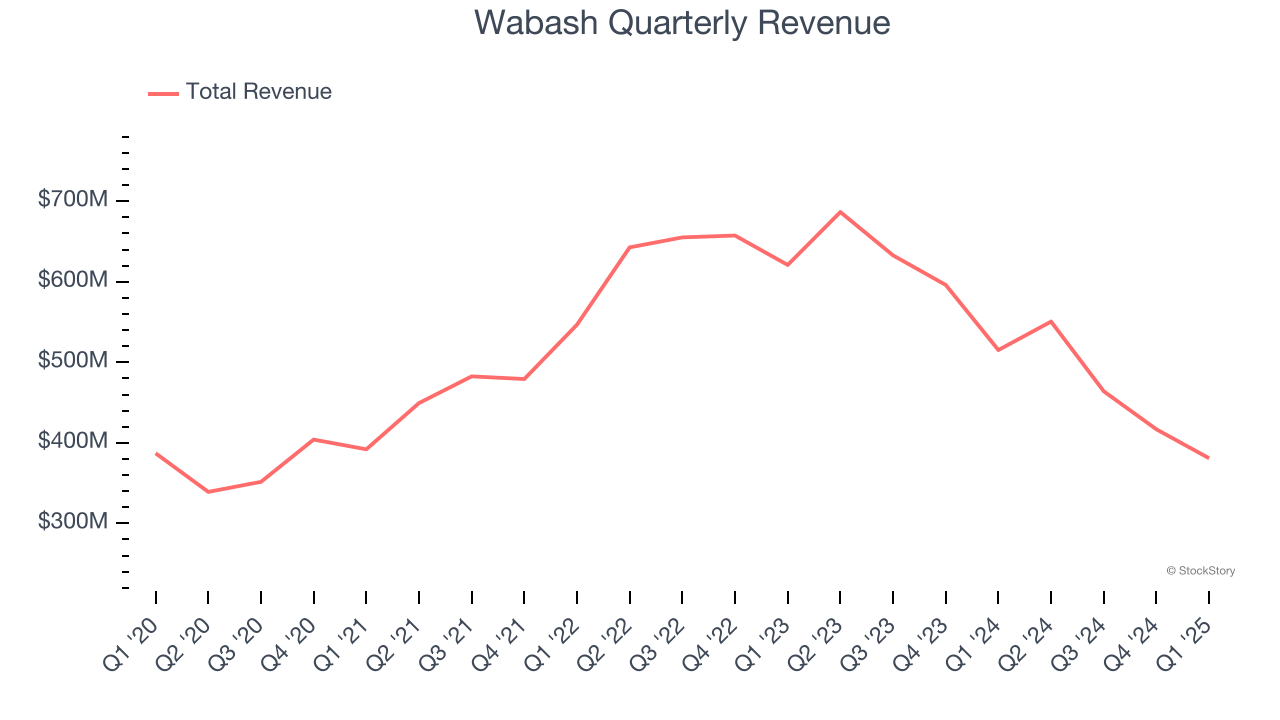
We at StockStory place the most emphasis on long-term growth, but within industrials, a half-decade historical view may miss cycles, industry trends, or a company capitalizing on catalysts such as a new contract win or a successful product line. Wabash’s recent performance shows its demand remained suppressed as its revenue has declined by 16.1% annually over the last two years. Wabash isn’t alone in its struggles as the Heavy Transportation Equipment industry experienced a cyclical downturn, with many similar businesses observing lower sales at this time. 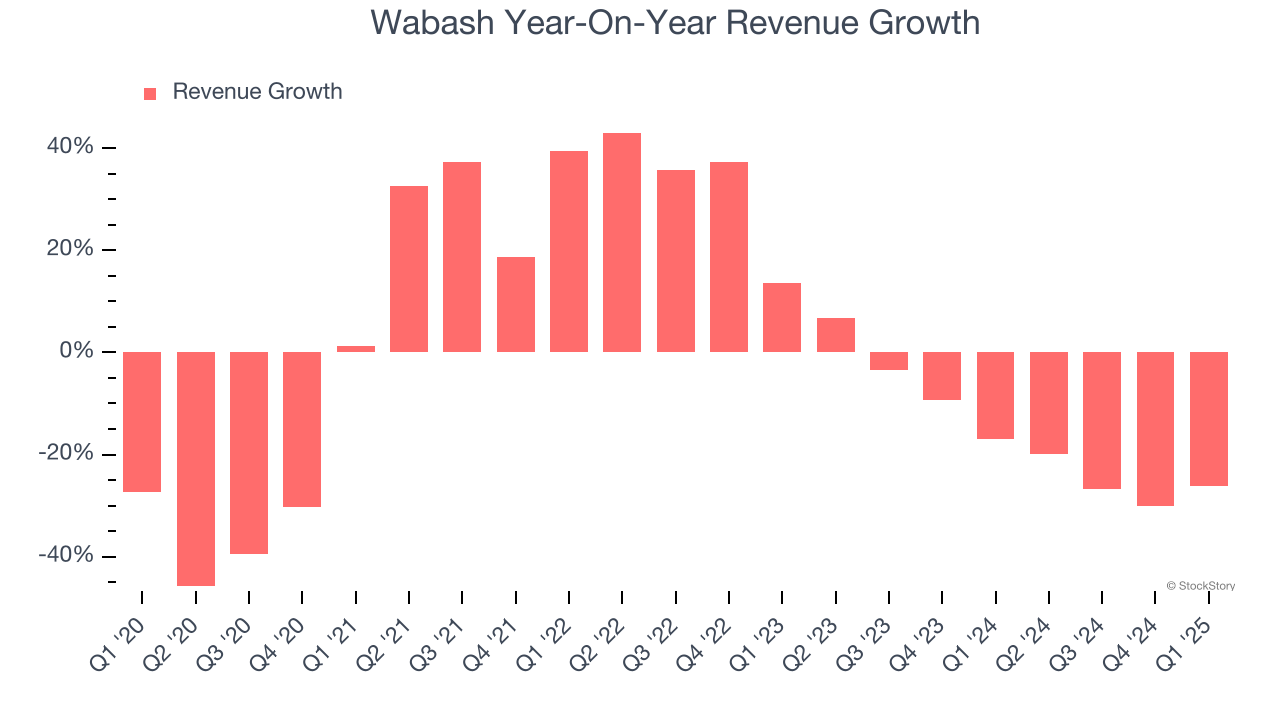
We can better understand the company’s revenue dynamics by analyzing its backlog, or the value of its outstanding orders that have not yet been executed or delivered. Wabash’s backlog reached $1.2 billion in the latest quarter and averaged 32.8% year-on-year declines over the last two years. Because this number is lower than its revenue growth, we can see the company hasn’t secured enough new orders to maintain its growth rate in the future. 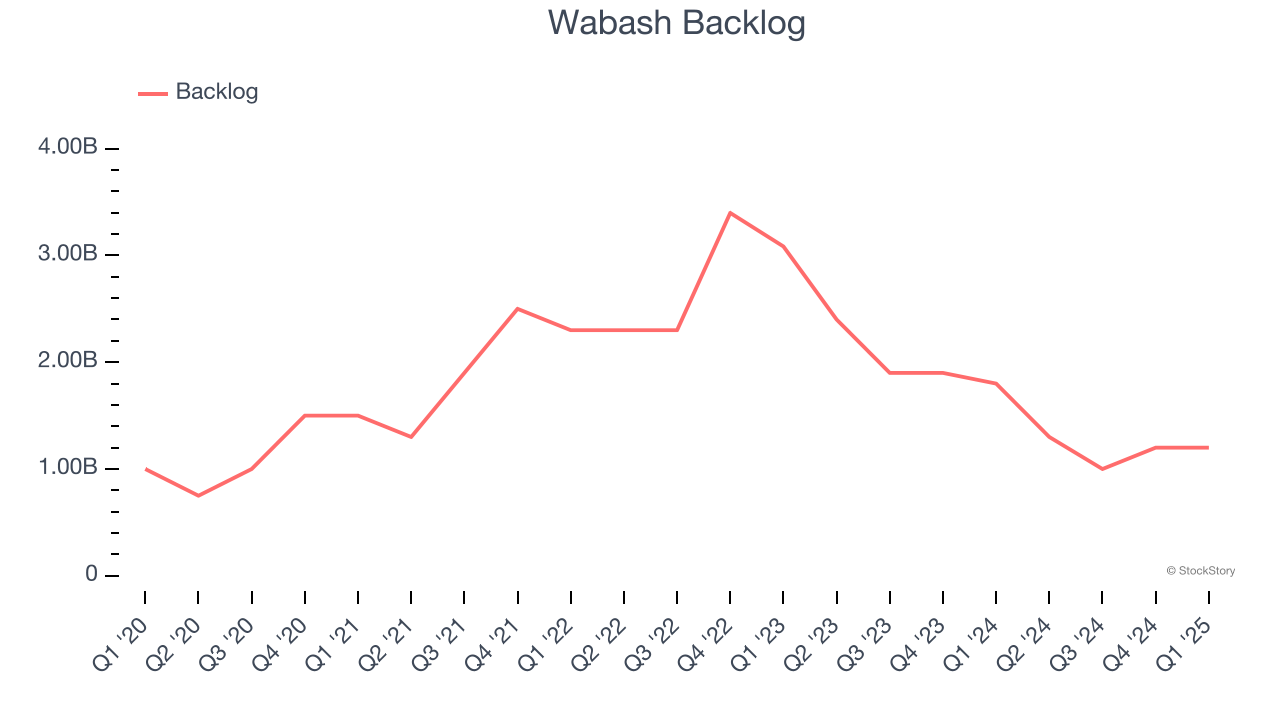
This quarter, Wabash missed Wall Street’s estimates and reported a rather uninspiring 26.1% year-on-year revenue decline, generating $380.9 million of revenue.
Looking ahead, sell-side analysts expect revenue to grow 9.3% over the next 12 months, an improvement versus the last two years. This projection is noteworthy and implies its newer products and services will fuel better top-line performance.
Unless you’ve been living under a rock, it should be obvious by now that generative AI is going to have a huge impact on how large corporations do business. While Nvidia and AMD are trading close to all-time highs, we prefer a lesser-known (but still profitable) stock benefiting from the rise of AI. Click here to access our free report one of our favorites growth stories.
Operating Margin
Wabash was profitable over the last five years but held back by its large cost base. Its average operating margin of 4.8% was weak for an industrials business. This result isn’t too surprising given its low gross margin as a starting point.
Looking at the trend in its profitability, Wabash’s operating margin decreased by 6.3 percentage points over the last five years. Wabash’s performance was poor no matter how you look at it - it shows that costs were rising and it couldn’t pass them onto its customers.
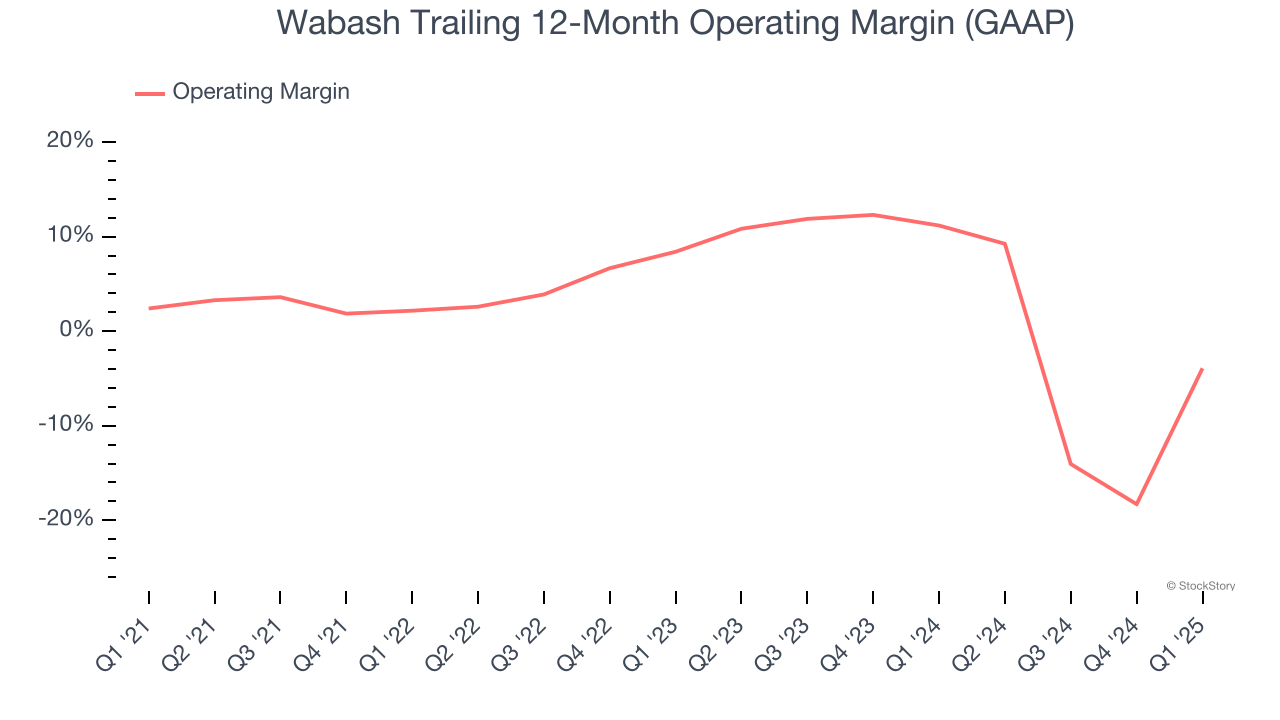
In Q1, Wabash generated an operating profit margin of 82.6%, up 76.8 percentage points year on year. The increase was solid, and because its revenue and gross margin actually decreased, we can assume it was more efficient because it trimmed its operating expenses like marketing, R&D, and administrative overhead.
Earnings Per Share
Revenue trends explain a company’s historical growth, but the long-term change in earnings per share (EPS) points to the profitability of that growth – for example, a company could inflate its sales through excessive spending on advertising and promotions.
Sadly for Wabash, its EPS declined by 30.6% annually over the last five years, more than its revenue. This tells us the company struggled because its fixed cost base made it difficult to adjust to shrinking demand.
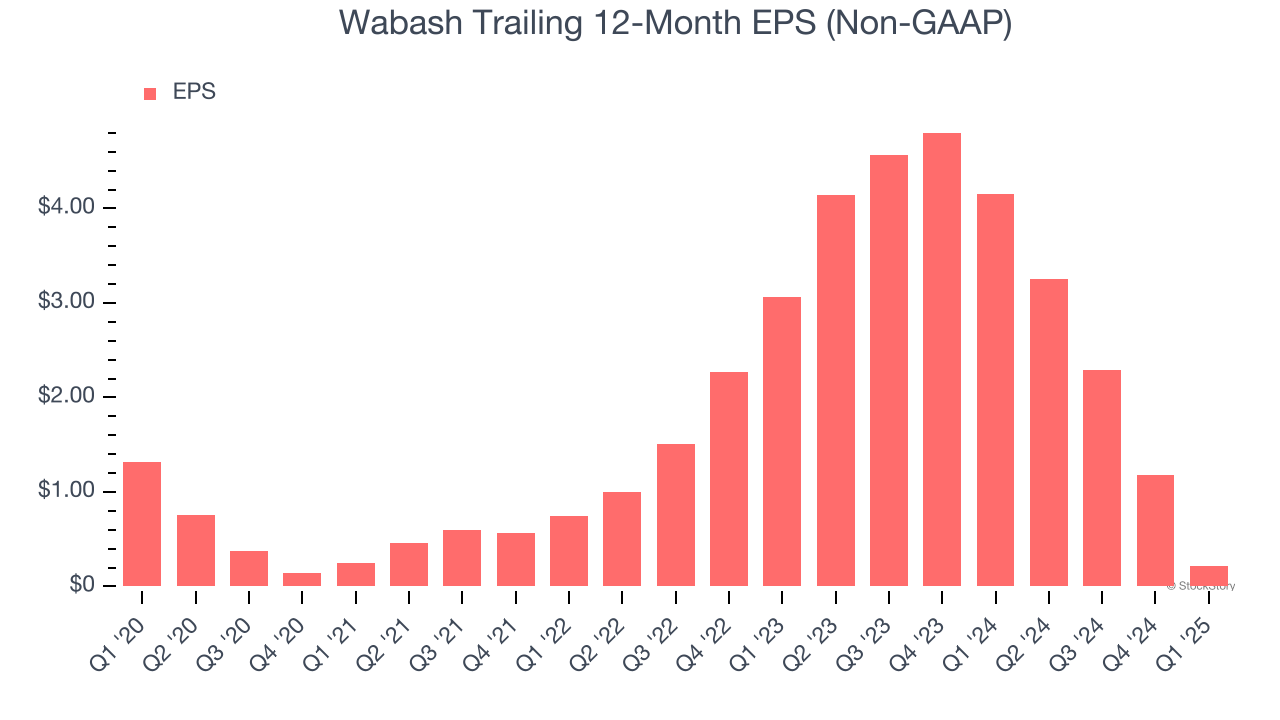
Diving into the nuances of Wabash’s earnings can give us a better understanding of its performance. As we mentioned earlier, Wabash’s operating margin improved this quarter but declined by 6.3 percentage points over the last five years. This was the most relevant factor (aside from the revenue impact) behind its lower earnings; taxes and interest expenses can also affect EPS but don’t tell us as much about a company’s fundamentals.
Like with revenue, we analyze EPS over a shorter period to see if we are missing a change in the business.
For Wabash, its two-year annual EPS declines of 73.7% show it’s continued to underperform. These results were bad no matter how you slice the data.
In Q1, Wabash reported EPS at negative $0.58, down from $0.39 in the same quarter last year. This print missed analysts’ estimates. Over the next 12 months, Wall Street expects Wabash’s full-year EPS of $0.21 to grow 352%.
Key Takeaways from Wabash’s Q1 Results
We struggled to find many positives in these results. Revenue and EPS in the quarter missed. Its full-year revenue guidance missed significantly and its full-year EPS guidance fell short of Wall Street’s estimates. Overall, this was a weaker quarter. The stock traded down 12.9% to $8.68 immediately after reporting.
Wabash’s earnings report left more to be desired. Let’s look forward to see if this quarter has created an opportunity to buy the stock. If you’re making that decision, you should consider the bigger picture of valuation, business qualities, as well as the latest earnings. We cover that in our actionable full research report which you can read here, it’s free.




